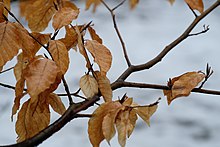



Marcescence is the withering and persistence of plant organs that normally are shed, and is a term most commonly applied to plant leaves.[1][2] The underlying physiological mechanism is that trees transfer water and sap from the roots to the leaves through their vascular cells, but in some trees as autumn begins, the veins carrying the sap slowly close until a layer of cells called the abscission layer completely closes off the vein allowing the tree to rid itself of the leaf.[3] Leaf marcescence is most often seen on juvenile plants and may disappear as the tree matures. It also may not affect the entire tree; sometimes leaves persist only on scattered branches.[4] Marcescence is most obvious in deciduous trees that retain leaves through the winter. Several trees normally have marcescent leaves such as oak (Quercus),[5] beech (Fagus) and hornbeam (Carpinus), or marcescent stipules as in some but not all species of willows (Salix).[6] All oak trees may display foliage marcescence, even species that are known to fully drop leaves when the tree is mature.[7] Marcescent leaves of pin oak (Quercus palustris) complete development of their abscission layer in the spring.[8] The base of the petiole remains alive over the winter. Many other trees may have marcescent leaves in seasons where an early freeze kills the leaves before the abscission layer develops or completes development. Diseases or pests can also kill leaves before they can develop an abscission layer.
Marcescent leaves may be retained indefinitely and do not break off until mechanical forces (wind for instance) cause the dry and brittle petioles to snap.[9] The evolutionary reasons for marcescence are not clear, theories include: protection of leaf buds from winter desiccation, and as a delayed source of nutrients or moisture-conserving mulch when the leaves finally fall and decompose in spring.[10]
Many palms form a skirt-like or shuttlecock-like crown of marcescent leaves under new growth that may persist for years before being shed.[11][12] In some species only juveniles retain dead leaves[13] and marcescence in palms is considered a primitive trait.[14]
The term marcescent is also used in mycology to describe a mushroom which (unlike most species, described as "putrescent") can dry out, but later revive and continue to disperse spores.[15] Genus Marasmius is well known for this feature, which was considered taxonomically important by Elias Magnus Fries in his 1838 classification of the fungi.[16]
- ^ Hitchcock, C. Leo; Cronquist, Arthur (2018). Flora of the Pacific Northwest (2nd ed.). Seattle: University of Washington Press. p. xxxviii, xliii. ISBN 978-0-29574-288-5.
- ^ Chisholm, Hugh, ed. (1911). . Encyclopædia Britannica. Vol. 17 (11th ed.). Cambridge University Press. p. 685.
- ^ "Abscission and Marcescence in the Woods | Vermont Center for Ecostudies". vtecostudies.org. Retrieved 2017-11-16.
- ^ "When Leaves Don't Leave » Arnold Arboretum". Arnold Arboretum. 2016-02-19. Retrieved 2017-11-16.
- ^ Berkley, Earl E. (1931). "Marcescent Leaves of Certain Species of Quercus". Botanical Gazette. 92 (1): 85–93. doi:10.1086/334178. JSTOR 2471297. S2CID 84953073.
- ^ George W. Argus. "88. Salix planifolia Pursh". Flora of North America. Vol. 7.
- ^ "Species of Oaks That Retain Their Dead Leaves". Garden Guides. Retrieved 2017-11-16.
- ^ Hoshaw, Robert W.; Guard, Arthur T. (1949). "Abscission of Marcescent Leaves of Quercus palustris and Q. coccinea". Botanical Gazette. 110 (4): 587–593. doi:10.1086/335558. JSTOR 2472663. S2CID 83740327.
- ^ Addicott, Fredrick T. (1982). Abscission. University of California Press. p. 51. ISBN 978-0-520-04288-9.
- ^ "When Leaves Don't Leave » Arnold Arboretum". Arnold Arboretum. 2016-02-19. Retrieved 2017-11-16.
- ^ L.B. Holm-Nielsen, ed. (1989). Tropical Forests: Botanical Dynamics, Speciation & Diversity. Academic Press. p. 161. ISBN 978-0-08-098445-2.
- ^ Dowe, John (2010). Australian Palms: Biogeography, Ecology and Systematics. Csiro Publishing. p. 160. ISBN 978-0-643-10185-2.
- ^ Dransfield, John; Uhl, Natalie W. (2008). Genera Palmarum: the evolution and classification of palms. Kew Pub. p. 294. ISBN 978-1-84246-182-2.
marcescent in immature [descriptive of several spp.]
- ^ Moore, Harold Emery; Uhl, Natalie W. (1982). Major Trends of Evolution in Palms. New York Botanical Garden. p. 69.
- ^ See introduction to Roy E. Halling "A revision of Collybia s.l. in the northeastern United States & adjacent Canada" Inst. of Syst. Botany, The New York Botanical Garden, Bronx, NY 10458-5126
- ^ E. M. Fries Epicrisis systematis mycologici (1838) Uppsala: Typographia Academica